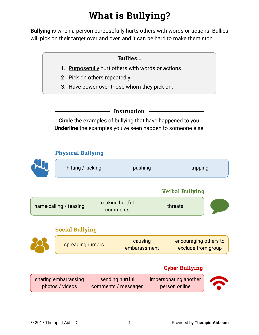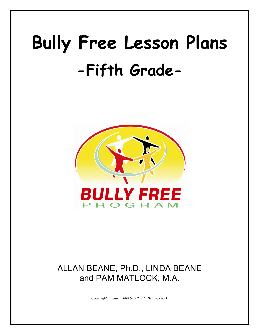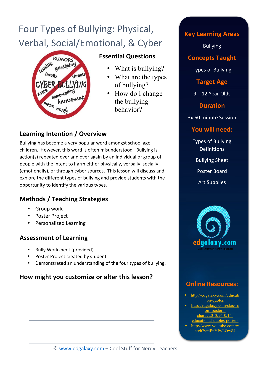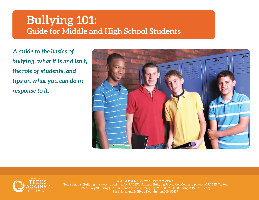Verbal Bullying Worksheets Results
Anti-bullying Bystander to Upstander - NSW Department of Education
• prepare relevant materials such as handouts, worksheets and posters and ensure there are adequate resources for each activity. Each group should have between six and eight students. Teachers should ... • Revise types of bullying (verbal, physical, social or online) and the visibility of the bullying behaviour – open (overt) or hidden ...
https://url.theworksheets.com/7t8d102 Downloads
Preview and Download !


What is Bullying? - Therapist Aid
Bullying. is when a person purposefully hurts others with words or actions. Bullies will pick on their target over and over, and it can be hard to make them stop. Bullies… 1. Purposefully hurt others with words or actions. 2. Pick on others repeatedly. 3. Have power over those whom they pick on. Circle the examples of bullying that have ...
https://url.theworksheets.com/5ff3179 Downloads
Preview and Download !


Toolkit: MENTALLY HEALTHY SCHOOLS Anti-bullying
Worksheets Lesson plans Assemblies and workshops Information and advice Guidance for school staff ... HEALTHY SCHOOLS. Toolkit: Anti-bullying Bullying can happen for any number of reasons, but if a child is seen as different in some way they can be more at risk. Bullying can be harmful and a˜ect c hildren’s m ental h ealth i n a n umber of ...
https://url.theworksheets.com/5iyf222 Downloads
Preview and Download !


Teasing, Harassment, and Bullying - Advocates for Youth
teasing, bullying or harassing us. Everybody will get a turn.” Ask students to form a line and to bring their worksheets with them. Then say: “Please look at your worksheet and the strategies you checked that you think would work for you. I will read a situation that has teasing, bullying, or harassment.
https://url.theworksheets.com/3vi234 Downloads
Preview and Download !


Bully Free Lesson Plans
Bullying can be found in every neighborhood, school system and school. To prevent and reduce it requires a systematic effort in each school. Ideally, there will be a school system wide commitment to preventing and stopping bullying. There must be adult involvement, including parents and others
https://url.theworksheets.com/4me157 Downloads
Preview and Download !


Four!Types!of!Bullying:!Physical, Verbal,Social/Emotional,&!Cyber!
bullying definition examples verbal using words, phrases, or verbal clues that embarrass, harass, or intimidate others name calling teasing racial comments sarcasm rumors mean spirited comments intimidating words social intimidating, controlling, or harmful actions that
https://url.theworksheets.com/7t9b71 Downloads
Preview and Download !


LESSON PLAN: I WAS JUST KIDDING! OVERVIEW - GLSEN
bullying through discussion of fictional scenarios and reflection on real-life situations. Students are provided with concrete guidelines that help them to understand when harmless joking has crossed the line to become disrespectful or mean. OBJECTIVES: • Students will be able to explain the difference between harmless teasing and verbal bullying
https://url.theworksheets.com/70zm46 Downloads
Preview and Download !


Bullying 101 - PACER
Verbal Using words, either out loud or in writing, is a common type of bullying because it’s quick, often done impulsively to elicit a response (and getting a response is typically the goal of bullying). Verbal bullying is also easier to do without catching the attention of adults, making it harder to detect and more difficult to reprimand.
https://url.theworksheets.com/7t9d56 Downloads
Preview and Download !


Grade 7 Sample Lesson Plan: Take a Stand, Lend a Hand – End Bullying
Provide at least 3 actionable steps one could take to prevent bullying in school and online. Include one catchy slogan to help people remember your message . Option 2: Advocacy Poster Create a poster on bullying explaining key points on how bullying affects health and safety.
https://url.theworksheets.com/7t9e47 Downloads
Preview and Download !


8. Bullying Scenes - Youth
8. Bullying Scenes Every bully is a coward in disguise! Themes Discrimination, Violence Level of complexity Level 2 Age 7 - 13 years Duration 60 minutes Group size 5 - 20 children Type of activity Discussion with some movement. Overview Children discuss bullying and then position themselves to show how they would respond to diff erent bullying ...
https://url.theworksheets.com/7t9f77 Downloads
Preview and Download !


<< Previous results Next results >>